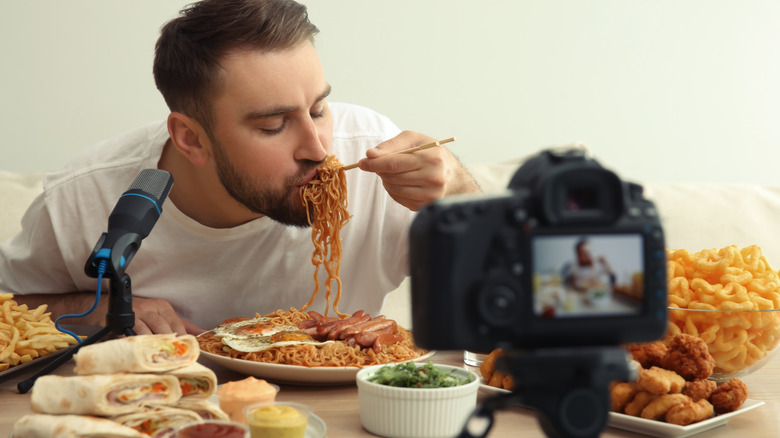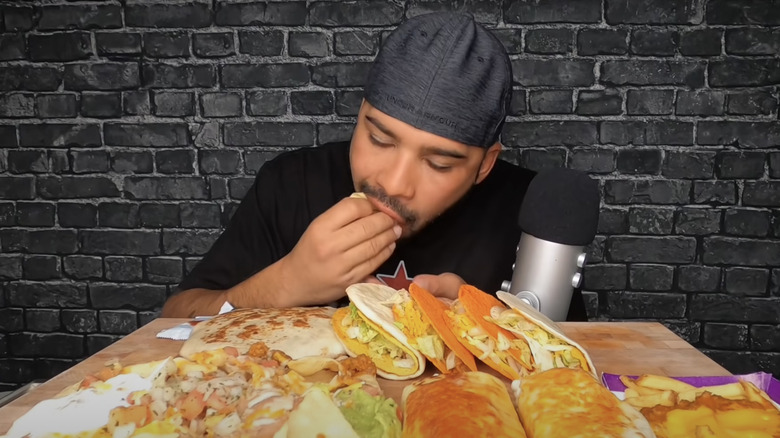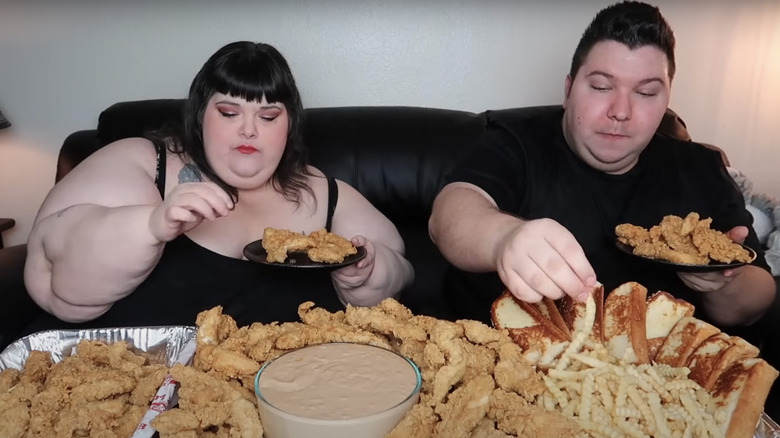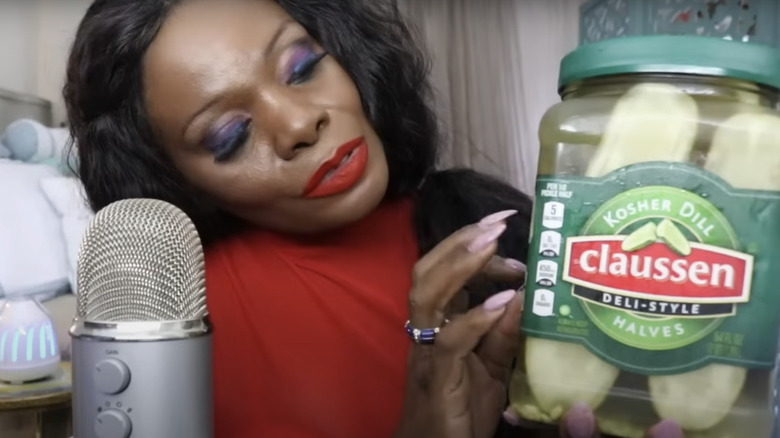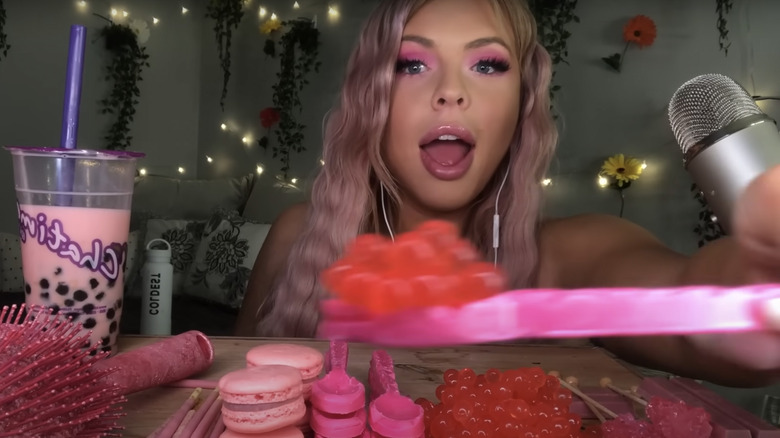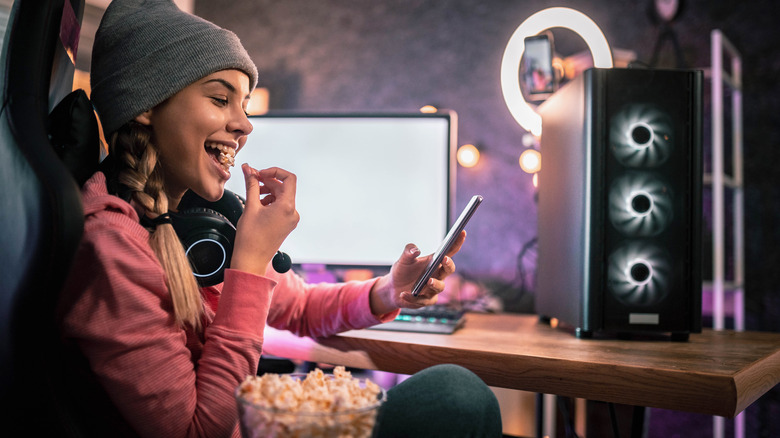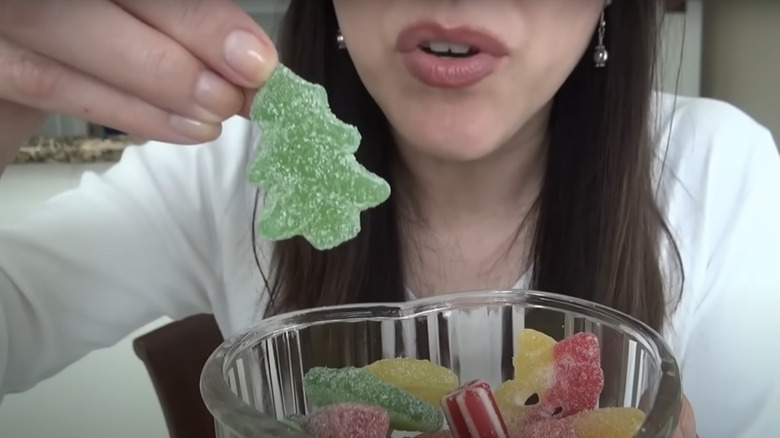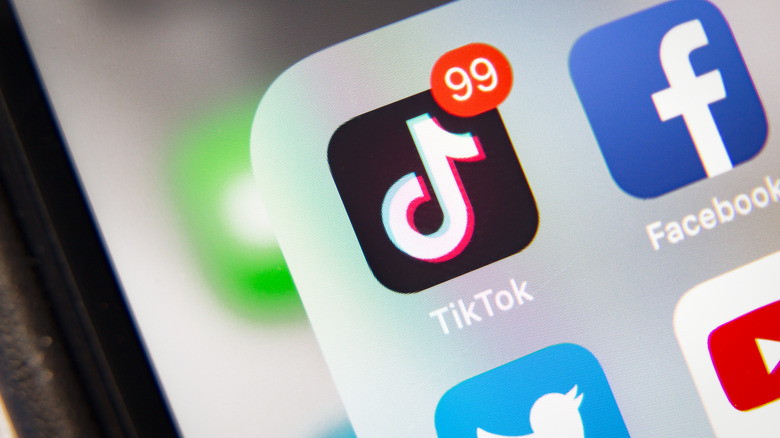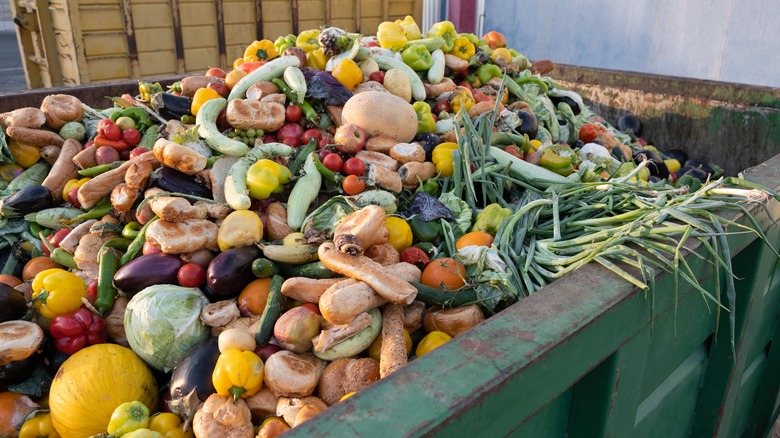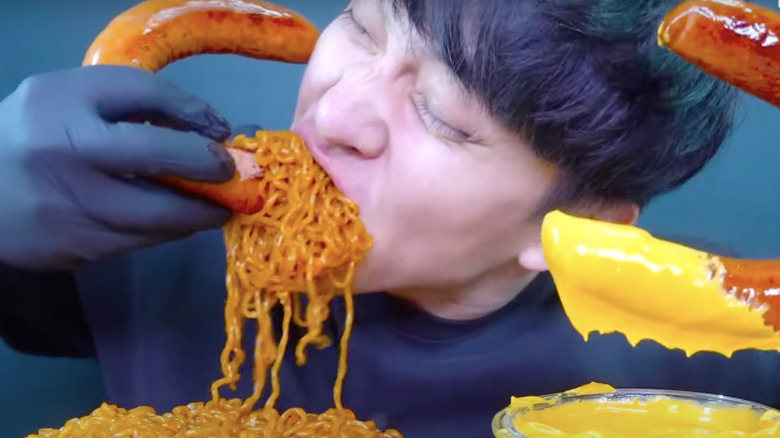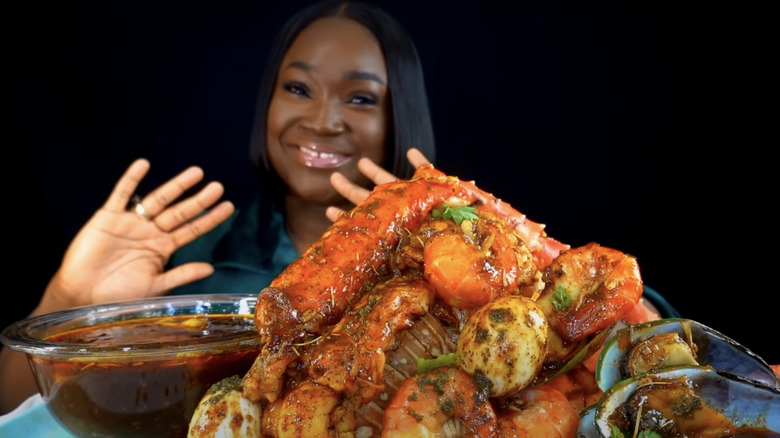What Exactly Is A Mukbang And Why Do People Watch Them?
Mukbangs are a global internet sensation that originally started in South Korea. At the beginning of the trend, hosts live-streamed themselves eating large quantities of food while interacting with viewers. These days, a lot of mukbangs are pre-precorded. They have diehard fans who swear by them because of the social interaction that this virtual communal dining experience brings. They say it's a great look into foods from around the world, and that they can scratch the itch if they are craving a certain food that not's available at the moment. Some fans even enjoy the ASMR experience which can be had from the sights and sounds of watching someone eating a good meal.
However, critics of the practice say that mukbangs promote unhealthy eating habits and overconsumption. They worry that mukbangs can harm the body image of viewers and damage the health of the content creator — all while contributing to the massive amount of global food waste. Yet despite all this, mukbangs continue to thrive. They tap into our fascination with food and serve as a form of escapism for both creators and viewers. Millions of people tune into them, so whether you're one of those people or not, here's everything you need to know about mukbangs.
This article includes discussion of eating disorders, mental and physical health, and body dysmorphia.
What exactly is a mukbang?
The first mukbangs started popping up online in South Korea in 2010. The name is a combination of the Korean words meokja and bang-song. Meokja (먹자) means "eat" and bang-song (방송) means "broadcasting," so when you put them together, you get something along the lines of "broadcasting eating." It's pronounced meok-bahng. In Korea, there's a very social eating culture, but the 2010s brought a shift in the lifestyle there, and soon, many young people were eating more and more meals alone.
The first mukbangs started to appear on a website known as AfreecaTV. Streamers would enjoy a meal on camera, sometimes talking, sometimes not. Others eating alone soon joined in and the pastime quickly grew in popularity. By 2014, the videos became so popular they began showing up on Instagram and YouTube, too. Today, thousands of mukbang creators make it their full-time job. Just imagine sitting down with a friend while they tell you about their day, except in this case, your friend is on a screen, and there's a feast laid out in front of them. That's the essence of mukbangs and why they appeal to so many people.
Critics think mukbangs promote overeating in viewers
Because the whole point of a mukbang is to eat on camera, some critics believe that the amount of food consumed could encourage those watching to eat far too much. "[A drawback of a mukbang] could be that it promotes unhealthy eating habits or glorifies overeating," Michelle Beaupre, Ph.D., LCSW and Clinical Director of Villa Oasis told Daily Meal. "It's important to remember that anything on social media may not always depict reality."
Most mukbangs show a large table filled with food to visually entice the viewer. However, viewers should be aware that, as Beaupre added, "many mukbang creators may not actually eat everything on their table in one sitting." Instead, they might just sample bits of food — leaving the rest just for show. They might also spit out portions of food after eating. You can never really know how the video might be edited if you aren't watching it live. "It's important for viewers to remember that they should listen to their own bodies and not try to mimic extreme eating challenges," Beaupre shared. In other words, eat when you're hungry and stop eating when you're full. If you're eating and watching a mukbang for company, remember that it's okay to finish your food before the creator is done.
Some mukbang creators might be harming themselves by eating too much
While it's common for mukbang creators not to actually eat all the food on the plates in front of them, it's also equally as common for some to finish every bite. A famous example is the popular creator Nikocado Avocado. He started out by creating vegan content, but swapped to mukbangs of all types of food in 2016. Since his career shift, viewers have expressed concern that Avocado, real name Nicholas Perry, is harming himself due to extreme weight gain, requiring the use of a mobility scooter amid other health concerns. Yet although the creator has spoken out about how his life has changed since overeating for a living, in some ways — he has admitted it has improved because of the financial living he is able to make. He even leans into his new lifestyle, titling videos like "100 Raising Cane's Chicken Fingers With Hungry Fat Chick" (Hungry Fatchick being the moniker of another mukbang YouTuber) as those viewing out of curiosity contribute to his income.
"Mukbang creators enter this golden-handcuff paradigm where they know what they're doing is incredibly unhealthy, but if they were to quit, their audience would likely grow smaller," Caleb Dueck, Director of Operations at Sperry Honey told Daily Meal. "So they wouldn't make nearly as much money from views or sponsorships." For some creators, putting their health on the line for what many people might consider to be an easy living is worth it.
Mukbangs create ASMR experiences in some
ASMR stands for Autonomous Sensory Meridian Response. It's a tingling sensation triggered by specific noises or visuals, like whispering, scratching, and tapping — or, in this case, hearing someone bite into a crunchy pickle or take a gulp of cold lemonade. ASMR videos on platforms like TikTok and YouTube aim to induce relaxation and euphoria in viewers. Many report feeling tingling and warmth, using ASMR for stress relief and as a sleep aid.
This is a big reason so many people enjoy mukbangs, as studies show that these tingling feelings can create positive emotions in viewers, leaving them feeling happy and relaxed. If viewers struggle with anxiety, depression, loneliness, or feeling overwhelmed, the simple act of watching a video of someone else enjoying a meal can do wonders for making them feel better. In a world where medical fixes for these problems might be out of reach and therapy is too expensive for many, being able to tune into something so calming is a lifesaver. Of course, as with any self-medication, there is potential for misuse. However, for those who watch for self-soothing purposes, the overall impact seems to be positive.
Mukbangs create a sense of community
One of the main reasons people enjoy watching mukbangs is that they're great at creating a sense of not being lonely. "I've observed that people who watch Mukbang videos often seek a sense of companionship or relaxation while eating alone," Niloufar Esmaeilpour, MSc, RCC, and SEP for Lotus Therapy & Counselling Centre said. "Many viewers may also find comfort or entertainment in watching others eat, especially if they have a passion for food or struggle with loneliness." In the post-COVID-19 world, more people than ever are experiencing loneliness. Whether you live alone in a new place, or work from home and don't get to talk to others during the work day, sitting down and eating a meal (even virtually) with someone who is also eating and friendly can be quite comforting.
Instead of another meal by yourself, suddenly you have friends (often in the thousands) enjoying a meal together. This is especially true during the live-streamed mukbangs as viewers can ask questions of the creator, like "What does it taste like?" or "How was your day?" allowing them to interact with a friendly face in real-time.
Livestreams are a big part of mukbang culture, to their credit and detriment
Although many channels are now popular because of their pre-recorded options on TikTok, Instagram, or YouTube, mukbangs started out as live interactive events. The nature of instant access to a creator can be great for a viewer feeling lonely, but things can potentially get rough in the comments. "Most Mukbang videos are live-streamed and have chat or comment functions to allow the viewer to interact with other people watching at the same time," Dr. Michelle Dees Board-Certified Psychiatrist at Luxury Psychiatry Medical Spa said. "This feature can give someone who feels completely alone in this world some virtual companionship during mealtimes." This is fantastic, but there is definitely a dark side, too.
Because most mukbang channels do not have moderators, "there is no filter on what viewers say during these livestreams or in the comments section afterward," Dees warned. "So, while it can be fun for both parties involved, the person doing the mukbang and the audience, there is always potential for negative feedback from viewers which may affect both sides negatively as well." It's great to be able to ask questions about recipes or stories the creator is telling, but the live stream also opens up the potential for cyberbullying, especially around eating disorders and body image issues.
Mukbangs give outsiders glimpses into culture
The ability to experience different foods online is a great pro of mukbangs. You can see others enjoy foods you've never eaten before (or perhaps never even heard of!). It's also a great way to gauge if you might enjoy something — or have curiosity answered about foods from far away places."The rise of mukbang content is largely due to how it makes us imagine that we're in the content creator's shoes, eating all that food," Caleb Dueck explained. "The colors are bright and the food looks delicious, and while watching, you're virtually experiencing what you see on screen."
If you've ever wondered what it's like to eat honeycomb, or perhaps try raw squid — there is a mukbang out there that can answer all of your questions. Some mukbang creators even show the cooking process, or discuss the food's cultural relevance, leading to a great sharing of knowledge and digital rapport building. "Most viewers know they won't be able to eat that quality or quantity of food anytime soon, but mukbang allows the viewer to experience that food for free," Dueck noted. "It's in an ever-popular category of content that gives us a front-row seat to something we otherwise wouldn't be able to experience, similar to celebrity house tours or vacation vlogs."
You can watch on TikTok and YouTube, but it's not the same as it used to be
When the videos first started, those streaming were focused on community and comfort. They weren't really making money from the practice and just ate and chatted with viewers. However, once creator funds began taking off, many Mukbang artists became mostly interested in building empires, sometimes at the expense of their health — or their viewer's body image. YouTube, TikTok, and Instagram all rely on algorithms to match viewers with content, so anyone wanting to make money as a creator on these platforms has to actively promote themselves to grow their channel. This need to promote leads to creators doing wild things like eating heaps of foods even to the point of sickness, or consuming controversial foods to gain attention and thus money.
"Many of these creators are more focused on gaining views and followers rather than promoting a healthy relationship with food," explained Mary Lawrence, LCSW and Clinical Director at Acera Health to Daily Meal. "As a result, there has been criticism of the authenticity and ethics behind mukbangs." The early days of streaming were quite different, before sensationalism became a part of mukbang culture. Now, there's a fine line between community fun and risky behaviour.
Critics say mukbangs contribute to food waste
In the USA, over 38% of all food goes uneaten, and even unsold, ending up being discarded instead. Some worry that because mukbangs encourage such a sizeable spread of different foods to be on display (especially to create an enticing thumbnail for the video), they are big contributors to the problem. "It contributes to food waste," Michelle Beaupre told us, in no uncertain terms. "Some mukbangs may feature excessive amounts of food that ends up being thrown away after the video is done. This can be seen as wasteful and insensitive, especially when there are people in the world struggling with hunger."
While mukbang creators are not the sole cause of the food waste problem, it might seem excessive to some, seeing a table covered in 1,000 fast food chicken nuggets, or watching someone order every single thing on the Taco Bell menu to eat in one sitting. This is because mukbang artists don't often eat all the food they lay out, especially in pre-recorded videos. Viewers might not realize this and attempt to recreate the spread at home, only to end up wasting heaps of food. To combat this, channels that cook large portions of food and give them to underserved populations have now begun to pop up online.
Some worry that mukbangs can harm a viewer's body image
When you see a person eating large amounts of food, it's natural to wonder how they maintain thinness. While some mukbang creators might have a naturally high metabolism, others might be harming themselves to look a certain way. At the same time, if you're struggling with body image, it can be distressing to see your favorite creator overconsume food, while still maintaining what much of society would consider a thin and desirable body type. "How come they can eat that much and be skinny? I eat less than them and I'm still not losing weight!" you might think. Studies show that watching these videos can trigger feelings of not being enough, creating eating disorders and body image issues.
There's often a dark side behind what you see on screen. "Some content creators may go through extreme measures to prepare for a Mukbang, such as not eating all day or purging after filming," Sal Raichbach LCSW, PsyD, and Chief Clinical Officer at Haven Health Management explained. "This can be harmful to their physical and mental health, and it's important to acknowledge the potential impact on both the creator and viewers." However, viewers should remember that many mukbang creators do not eat all the food they appear to. Even if they say they are eating everything, they are often not telling the truth — they are simply taking one bite.
Supporters think the videos can help with binge eating recovery
Critics argue that mukbangs are dangerous because they encourage binge-eating behaviors due to overconsumption. However, others in the recovery space believe the videos can actually be a great tool to help those struggling to overcome urges. "If someone used to struggle with binge eating, these types of videos may bring them back to where they started," explained Elvis Rosales, LCSW and Clinical Director at Align Recovery Centers. "As many people know binge eating disorder is scary and is something that you don't want to relapse into." This is the dark side, as the videos might serve as a trigger.
"Though there are some good points too," Rosales continued. "These kinds of videos could be just what someone needed in order to help them gain weight. They also get the satisfaction of having someone else out there do all the overeating they ever fantasized about without going through any consequences themselves." By allowing someone else to do the eating for them, those in recovery can maintain their boundaries without harming themselves or compromising their progress.
If you or anyone you know needs help with an eating disorder or mental health, assistance is available. Please contact the relevant resources below:
- Contact the Crisis Text Line by texting HOME to 741741, call the National Alliance on Mental Illness helpline at 1-800-950-NAMI (6264), or visit the National Institute of Mental Health website
- Visit the National Eating Disorders Association website or contact NEDA's Live Helpline at 1-800-931-2237. You can also receive 24/7 Crisis Support via text (send NEDA to 741-741)
